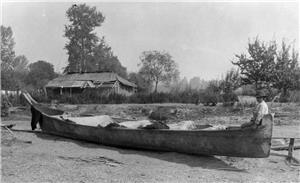On January 19, 2001, the Duwamish Tribe wins federal recognition. However, fewer than 48 hours later, the tribe learns that President George W. Bush has suspended a batch of President Clinton's 11th-hour orders, including federal recognition of the Duwamish. The Duwamish were the indigenous inhabitants of the Seattle area. They have been seeking recognition since 1979, when U.S. District Judge George Boldt (1903-1984) found that the tribe had not existed continuously as an organized tribe (within the meaning of federal law) from 1855 to the present, and was therefore ineligible for treaty fishing rights.
A 10-year gap in the record (from 1915-1925) prompted Boldt's decision as well as a denial of recognition by the Bureau of Indian affairs in 1996. The tribe has assembled additional evidence for its active existence through the decade in question, which prompted the Bureau of Indian Affairs to reverse its 1996 decision. The Duwamish, including Chief Seattle (178?-1866), for whom Seattle is named, were among the signers of the Point Elliott treaty, signed on January 22, 1855, and ratified by the United States Senate in 1859. The treaty guaranteed both fishing rights and reservations.
Seattle's Indigenous People
Chief Seattle and other members of the Duwamish Tribe greeted new settlers when they arrived in 1851, and provided guides, canoe transportation, and other aid (labor for Henry Yesler's first sawmill, potatoes that the Duwamish grew near Renton), which enabled the settlers to survive and to thrive. Chief Seattle's mother was Duwamish and his father was Suquamish. He built an alliance between the two tribes. The Duwamish Tribe occupied at least 17 villages near Elliott Bay, Duwamish River, Black River (which no longer exists), Lake Washington, and Lake Sammamish.
The Duwamish signers of the Point Elliott Treaty were Chief Seattle, and Duwamish sub-chiefs Ts'huahntl, Now-a-chais, and Ha-seh-doo-an.
The Duwamish of Renton
The tribe, when recognized, will be known as the Duwamish of Renton. There are 560 members. Tribal Chairwoman Cecile Hansen said that the first focus will be to build a cultural center -- a traditional longhouse on the Duwamish River. Hansen is the great-great niece of Princess Angeline or Kikisoblu (1820?-1896), who was the eldest daughter of Chief Seattle.
The 1996 decision against the tribe had to do with a 10-year gap in records for the decade 1915 to 1925, which made a break in the continuous existence requirement (within the meaning of federal law) for tribal recognition. The tribe carried out additional work to assemble evidence for that 10-year period, from Catholic church records, news reports, oral histories, and further tracing of bloodlines. Ken Tollefsen, a retired Seattle Pacific University anthropologist, helped to assemble the additional data.
The Department of Interior's Bureau of Indian Affairs branch of Acknowledgement and Research recognized the Duwamish Tribe the day before the inauguration of George W. Bush as president. It was thus one of the last acts of the Clinton administration. Fewer than 48 hours later, the tribe learned that President Bush suspended a batch of his predecessor's 11th-hour orders, including federal recognition of the Duwamish.
In September 2001, in a "notice of final determination," tribal status was denied. The Bureau of Indian Affairs said the Duwamish failed to meet all seven required criteria for recognition: It wasn't identified as having a continuous history from early times to today and hasn't maintained a political authority.
Tribal chairwoman Cecile Hansen insisted, "The decision that came down in January was the right decision. We fulfilled all the criteria and they're the ones that dropped the ball. We have known and felt the effects of 20 years of administrative inaccuracies, delays and the blasé approach in effectively handling and fairly processing the Duwamish petition" (Gilmore).

